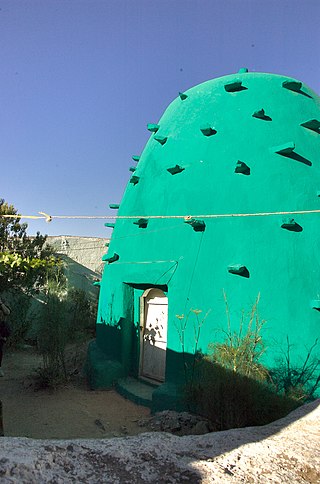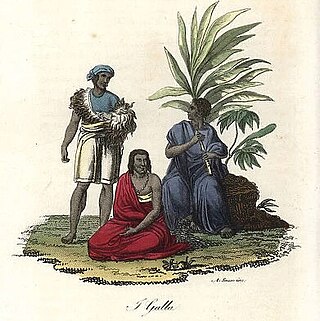History

The Harla are credited by the present-day inhabitants of parts of Ethiopia, Somalia, and Djibouti with having constructed various historical sites. [6] Although now mostly lying in ruins, these structures include stone necropoleis, store pits, mosques and houses. Cave drawings are also attributed to the Harla. [7]
Tradition states one of Harla's main towns was Metehara and the area between Harar and Dire Dawa is still referred to as Harla. [5] The Harla inhabited Chercher and various other areas in the Horn of Africa, where they erected various tumuli. [8] According to historian Richard Wilding, tales indicate Harla lived in the interior of Ogaden and by the seashores prior to Somali and Oromo movements into these regions. [9]
The Harla Kingdom existed as early as the sixth century; it would later be influenced by Islam sometime in the eighth century. [10] In the ninth century, the earliest known Muslim kingdom in the Horn of Africa, the Maḥzūmī dynasty sprang up in Harla country. The Maḥzūmī capital of Walale was in Northern Hararghe. [11] [12] Harla state leaders were commonly known as Garad and their religious elite carried the honorific title Kabir. [13] [14]
According to folklore, the Harla reportedly had a queen named Arawelo, who ruled much of the eastern parts of the Horn of Africa. In Zeila, a clan called Harla claims to be related to the ancient people. Locals in Zeila also attested that the old town of Amud was built by the Harla. [15]
The influx of Arab immigrants such as Ābadir ʻUmar Āl-Rida into Harla territory would lead to the development of the town of Harar, known then as Gēy. [16] Harar would become the leading center of Islam in the Horn of Africa. [17] Archaeologist Timothy Insoll discovered stoneware in Harla town resembling that found in Harar. [18]
According to the Harari chronicle, Abadir led prayer as Imam and inquired about the states grim condition. [19]
After the prayer nobody stayed in the mosque except for the crowd mentioned (from Mecca). They asked each other: 'What is it about us? We see neither their emir nor their vizir. Rather, they are all of one rank. Then a man of them said: 'I also heard from them (the natives) that 25 years prior, they were a people, the Harla, until death destroyed them and they scattered, fleeing from disease and famine.
— Yahya Nasrallah, Fath Madinat Harar
Conflict and decline

According to thirteenth century Arab geographer Ibn Sa'id al-Maghribi, the country of Harla was east of the Ethiopian Empire and north of Zanj. Harla clans descendant from Sa'ad ad-Din II participated in the sixteenth century Ethiopian–Adal War. [20] Ibn Said further states the Harla territory passed the Blue Nile, north east and ended near the shores, the Harla made a living in the gold and silver mines. [21]
According to Ethiopian accounts, in the 14th century, the Harla led by their Imam Salih allied with the Ifat Sultanate [22] and battled the forces of emperor Amda Seyon I in what is now northern Somalia. [23] [24] In the 15th century, Emperor Zara Yaqob of Ethiopia sold several Abba Estifanos of Gwendagwende supporters to Harla slave traders of Adal as punishment for joining the Stephanite sect labelled heretic by the Ethiopian Orthodox Tewahedo Church. [25] A power struggle had developed in the early 16th century between Harla emirs of Harar and Walashma dynasty in which Ahmad ibn Ibrahim al-Ghazi would assume power by executing the Walashma Sultan Abu Bakr ibn Muhammad. [26]
In the middle of the 16th century, the Adal Sultanate led by Harla and their Somali allies invaded Abyssinia. [27] Harla were part of Adal's elite military unit called the Malassay. [28] The Ethiopian–Adal War was in response to the death of Harla leader of Adal, Imam Mahfuz, killed in single combat, by the warrior-monk Gebre Andrias in the early reign of Emperor Dawit II. [29] [30] [31] In the wars against Emperor Sarsa Dengel, the Harla were led by the Sultan Muhammad ibn Nasir. [32] [33] [34]
The late sixteenth century saw the Oromo people penetrate portions of Ethiopia and Somalia, expansively invading upward from the Lower Jubba eventually incorporating Harla territory. [35] The Harla would move the Adal capital to the oasis of Aussa in 1577, and later establish the Imamate of Aussa before being overthrown by the Afar dynasty of Mudaito in the eighteenth century. [36] [37] [38] In 1893 British led expeditions, came across an ancient town in Nugaal Valley, Somalia, the local Dhulbahante clan alleged the Harla had lived in the area before the Oromo invasions. [39] In 2017, a Harla town that produced jewelry was discovered by archaeologists. The architecture of a mosque found affirmed Harla had ties with Islamic centers in Tanzania and Somalia. [40] The Harla tribe's disappearance could have been due to the Ethiopian–Adal War in the sixteenth century, destitution, or assimilation. [41]
Strong evidence suggests that during the Oromo migrations, the remaining Harla retreated behind the walls of Harar and were able to survive culturally. [3] Local folklore from the Harla village near Dire Dawa, however, claim the Harla were farmers from the Ogaden and went extinct because of their arrogance, refusing to fast in Ramadan, and attempts to have the Quran written in Harla, hence were cursed by God. [42] According to the Gadabuursi clan, the Harla committed major sins through excessive pride. [43] Enrico Cerulli and others state Harla were a distinct group originating from the Harari region; however, due to the collapse of Adal, they were assimilated by Somalis as well as Afars. [44] [45] [46]









